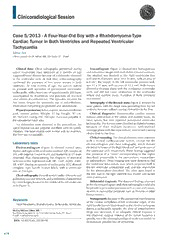
Case 5/2013 - A Four-Year-Old Boy with a Rhabdomyoma-Type Cardiac Tumor in Both Ventricles and Repeated Ventricular Tachycardia. PDF
Preview Case 5/2013 - A Four-Year-Old Boy with a Rhabdomyoma-Type Cardiac Tumor in Both Ventricles and Repeated Ventricular Tachycardia.
Clinicoradiological Session Case 5/2013 - A Four-Year-Old Boy with a Rhabdomyoma-Type Cardiac Tumor in Both Ventricles and Repeated Ventricular Tachycardia Edmar Atik Clínica privada do Dr. Edmar Atik, São Paulo, SP – Brazil Clinical data: Chest radiography performed during Ecocardiogram (Figure 2) showed two homogeneous upper respiratory tract infection at 5 months of age and echodense images with well-defined round contours. suggested heart disease because of a deformity observed The smallest was located in the right ventricular free in the ventricular arch. At that time, echocardiography wall and its diameters were 39 x 21 mm, with an area of confirmed the presence of two tumor masses in both 6.9 cm2; the largest, in the left ventricular anterior wall, ventricles. At nine months of age, the patient started was 51 x 37 mm, with an area of 12.5 cm2. Both masses to present with episodes of paroxysmal ventricular showed a cleavage plane with the contiguous ventricular tachycardia, with a heart rate of approximately 200 bpm, walls and did not cause obstruction in the ventricular accompanied by diaphoresis and paleness, all reverted inflow and outflow tracts. Function of both ventricles after electrical cardioversion. The episodes recurred for was normal. five times, despite the systematic use of antiarrhythmic Tomography of the thoracic aorta (Figure 2) showed the medication comprising propranolol and amiodarone. same pattern, with the larger mass protruding from the left Physical examination: Active, eupneic, mucous membranes ventricle, however without causing obstruction to the flow. pink, normal pulses. Weight: 17 kg. Height: 97 cm. Clinical diagnosis: Biventricular cardiac tumors BP: 90/52-61 mmHg. HR: 100 bpm. Aorta non-palpable in without obstruction in the inflow and outflow tracts, no the suprasternal notch area. heart failure, but with repeated paroxysmal ventricular tachycardia. The tumors were classified as rhabdomyomas No deformities were observed in the precordium; the because of their multiple locations, well-defined apical impulse was not palpable and there were no systolic cleavage plane with the myocardium, and for not causing impulses. The heart sounds were normal with no murmurs. obstruction to the flow. The liver was not palpable. Clinical reasoning: The clinical elements were consistent with a normal cardiovascular system, except for the Laboratory tests electrocardiogram and chest radiography, which showed Electrocardiogram (Figure 1) showed normal sinus electrical ischemia of the high lateral wall and protrusion of rhythm and signs of left ventricular overload. QR complex in the ventricular arch, respectively. These findings suggested aVL with negative T wave in aVL and isoelectric in D1 were the presence of a “mass” corresponding to the region observed, thus characterizing the diagnosis of electrical described, presumably in the pericardium, myocardium ischemia of the high lateral wall. AP: +60o. AQRS: +80o. or endocardium. Other imaging tests were decisive to find AT: +90o. During an episode of tachycardia, ECG showed the ventricular intracavitary mass which projected itself in complete right bundle branch block, with a ventricular the left ventricular anterolateral wall, and was responsible rate of 210 bpm. for the abnormalities described. The other mass found in the free wall of the right ventricle was smaller and lacked Chest radiography showed normal cardiac silhouette and clinical relevance. pulmonary vascular network, and a deformity characterized by a mild bulging located in the middle of the left ventricular Differential diagnosis: The abnormal findings observed arch (Figure 1). in the electrocardiogram and chest radiography could also be present in pericardial processes such as cysts and tumors, or even in myocardial processes such as fibroma or other benign tumors. Keywords Management: Because of the paroxysmal manifestation of the cardiac arrhythmia of left ventricular origin, of the Heart Neoplasms; Rhabdomyoma; Tachycardia, Ventricular. right bundle branch block found on the electrocardiogram during a tachycardia episode, the dose of antiarrhythmic Mailing Address: Edmar Atik • drugs was increased. If an adequate clinical response is Rua Dona Adma Jafet 74 , cj 73 01308-050 São Paulo, SP - Brazil E-mail: [email protected] not observed, surgical removal of the tumor becomes a priority, since the electrophysiological study was unable to DOI: 10.5935/abc.20130193 demonstrate possible foci of arrhythmia. e74 Atik Biventricular rhabdomyoma, ventricular tachycardia Clinicoradiological Session Figure 1 - Electrocardiogram showing electrical ischemia of the high lateral wall with characteristic abnormalities in D1 and aVL. Chest radiography shows a protrusion in the ventricular arch corresponding to the intracavitary left ventricular mass. Comments: The clinical manifestations of benign and the diagnostic imaging tests – echocardiography tumors of the heart commonly include heart failure, and MRI, confirmed the diagnosis. Today, arrhythmias supraventricular and ventricular arrhythmias, and sudden in general may be better treated by means of more events such as syncope and low cardiac output, whether or appropriate medications, of ablation after the triggering not accompanied by cerebral symptoms. They are usually electrophysiological mechanism has been established, or diagnosed during an episode of infection, convulsion or even of surgical resection of the tumor mass that is causing fainting. In the present case, chest radiography was the first the arrhythmia. All are valid and adequate options. A more test to raise the diagnostic hypothesis of a cardiac tumor conservative approach, with the use of antiarrhythmic because of the bulging observed in the ventricular arch. drugs, should be the first option. Over time, other steps The electrical ischemia found in the electrocardiogram may be necessary to achieve the clinical control of the may characterize the exact location of the abnormality, ventricular arrhythmia. Arq Bras Cardiol. 2013;101(4):e74-e76 e75 Atik Biventricular rhabdomyoma, ventricular tachycardia Clinicoradiological Session Figure 2 - Echocardiogram, in cross-sectional view, showing the diagnostic elements of the biventricular intracavitary mass not causing obstruction to the flow (A). Tomography shows that the tumor on the left side fills the ventricular cavity more than does the tumor on the right side (B). e76 Arq Bras Cardiol. 2013;101(4):e74-e76
